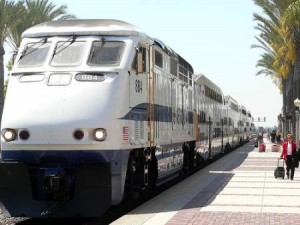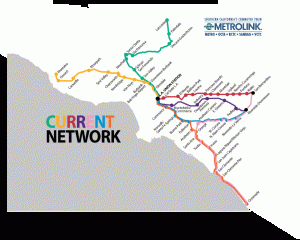If you want to hear about rail in Pasadena, come out tonight. I’ll be discussing the past and future of the Gold Line light rail to Pasadena and beyond, at the Downtown Pasadena Neighborhood Association’s annual meeting at 7:00 p.m. I’ll also cover Measure M on the county ballot and what it might do for a proposed Gold Line extension beyond the current terminus in Azusa. More info here.
And if you’re a lawyer in need of some environmental law discussion (and continuing legal education credits), come out tomorrow to the Los Angeles County Bar Association’s (LACBA) 15th Annual Environmental Law Fall Symposium: The Courts, the Climate, and the Deal: The Latest Developments. I’ll be on a panel discussing “Climate Change Regulation in California: 2020 and Beyond,” mainly focusing on the murky future of the state’s cap-and-trade program. That conference will be held tomorrow at the InterContinental Los Angeles Century City, from 11:30 to 4:3pm.
Hope to see you at one or both!
In my book Railtown, I write how the Pasadena Gold Line light rail received approval over other, more meritorious transit corridors in Los Angeles, in part because there was little organized opposition to the route. While the major factor was the strong, bipartisan political support for the line, as opposed to the opposition to rail in West L.A. and the San Fernando Valley among other places, the Pasadena line was fortunate to travel through an industrial, low-income, high-renter area. In short, it was a community that lacked the resources and desire to protest.
But longtime Angeleno Robert L. Davis, who lived near the line, recalled for me a late-entry opposition group:
Once the project looked like it would really be built, there was a group that wanted it to be in a subway, or at least a trench all the way through Pasadena. Not sure, but I think some South Pasadena residents got into the act. They called themselves “No Blue Line at Grade” [at the time the Pasadena Line was considered an extension of the Long Beach Blue Line] or to use the rather unpleasant-sounding acronym NOBLAG. They lobbied the Public Utilities Commission, which among other things has jurisdiction over grade crossings, complaining about traffic tie-ups, noise, etc. etc. Had the PUC gone along with NOBLAG’s ideas, the project probably would have been scuttled as way too expensive.
Davis wrote to the PUC to urge them to reject the NOBLAG request, and he shared his letter with me. He was unsympathetic to their concerns:
If someone said, “Have you ever lived next door to a busy railway?”, I can reply, “I lived the first eleven years of my life next to a Pacific Electric ‘Red Car’ line in Monrovia”. This had a worn-out track with bumpy joints, carrying heavy interurban cars and a daily freight train with (usually) flat wheels on some of the cars. Modern light rail trains run on welded rails and the cars are designed for quiet operation. In San Francisco the J and M rail lines pass so close to some houses you can almost see what’s on TV. The Pasadena line used to carry 70 car freight trains and 18 car passenger trains with two to seven diesel locomotives, so it’s not like trains are something never seen or heard before.
Davis also rejected the idea that the train would hurt property values:
One may hear complaints about property values dropping; in most places where light rail goes into service, values rise, and “near light rail station” is a selling point. Many cities where light rail projects were greeted with skepticism now have suburbs lobbying to be next on the list for line extensions.
I agree with his general point, although the squeaky rail cars on the twisty tracks probably hurt property values. The train seems to go almost right through some homes’ backyards. Plus, some studies I’ve seen do show a drop-off in property value for homes right next to a station, although values increase beyond that immediate affected range, as Davis indicated.
In general, I don’t begrudge a group of neighbors organizing to voice their concerns, and policy makers should mitigate negative impacts whenever feasible. But I’m glad the CPUC did not effectively kill the project based solely on those objections. The larger lesson here is that more powerful residential groups have success influencing local elected officials and litigating to delay and kill projects. The Pasadena NOBLAGs simply did not have that clout, and they lost as a result.
Longtime Angeleno Robert L. Davis is back with some follow-up memories of Pasadena rail. As an electric rail fan, he was excited back in the 1990s at the prospect of a new Metro light rail line to Pasadena, what would eventually become the Gold Line. However, he notes in the history that there was discussion of building it as part of Metrolink, the Southern California long-haul commuter rail that started in the early 1990s and shares tracks with freight lines:
Back in the early 1990s, when Santa Fe was in the process of selling of the 2nd District (LA to San Bernardino via Pasadena and Pomona), there was one school of thought among both SCRRA [Southern California Regional Rail Authority, which operates Metrolink] and Metrolink and a coterie of railfans that believed that the line through Pasadena should have been upgraded for faster operation, but should have remained a diesel-powered mostly single track line, which would accommodate both freight and passenger trains meeting FRA standards. This possibility was still under discussion one day when I was a volunteer trainman on a special train run by Orange Empire Railway Museum for SCRRA personnel. They wanted to see the Santa Fe San Jacinto Branch between Perris and Hemet, so we gave them a ride on our ex-Soo Line business car (which has played a political campaign car in movies). During the trip I heard the SCRRA folks discussing making the line through Pasadena a Metrolink route.
I covered the origins of the Gold Line in my book Railtown but did not discuss this possibility. Davis favored a non-diesel train, represented by light rail, over the smelly Metrolink option. I too favor electric transportation generally over diesel.
However, given the expense and amount of time it took to build the Gold Line, coupled with the relatively disappointing ridership numbers due to the slow route and lower population density of the corridor and San Gabriel Valley it serves, I wonder if going with the more expensive light rail was a mistake.
Metrolink was able to get up and running very quickly and cheaply, thanks in large part to a California Environmental Quality Act (CEQA) exemption for new rail on existing freight rights-of-way and the easier infrastructure associated with commuter trains, as opposed to light rail (no overhead power lines, for example). It might have been a more appropriate technology for that corridor.
On the diesel vs. electricity issue, the California High Speed Rail Authority has plans to electrify Metrolink as part of the connection between Union Station and the Transbay Terminal in San Francisco (with the caveat that ongoing litigation may halt those plans). So ultimately, you might have had a cheaper system, up and running more quickly, with future plans to be electrified. With the freed up cash, L.A. Metro could have connected more neighborhoods to rail throughout the region.
Davis certainly wanted the line to be built more quickly:
Some of us had hoped that the Blue Line [as it was known then] to Pasadena would be done in time for the100th anniversary of the original electric railway from LA to Pasadena opening in 1895. As we all know, it took another eight years to make it happen, with all sorts of political goings on before any track was laid.
But many leaders from the area insisted on light rail, as the nicer, gold-plated option for their constituents. As I discuss in the book, the line had bipartisan federal support from Republican Congressman David Dreier, strong local support from Mayor Richard Riordan and Councilmember Richard Alatorre, and state support from then state legislator Adam Schiff. When Metro later went broke and couldn’t pay for the line, these powerful leaders removed the construction and financing from Metro in order to ensure it could get built. However, had these leaders been willing to explore different options for the corridor, perhaps passenger trains would have been running in time for that anniversary, and the region as a whole might have been better served as a result.




